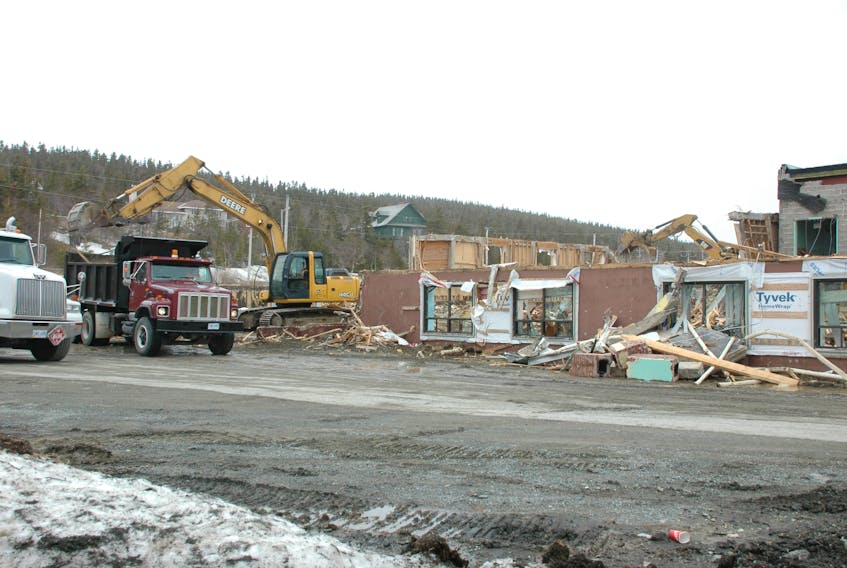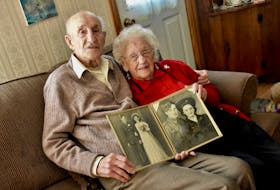ST. ANTHONY, N.L. — ST. ANTHONY, N.L. – Old memories crop up as walls of the old school tumble down.
The demolition of Harriot Curtis Collegiate was carried out this past week and it was met with mixed feelings for those who spent much of their lives at the St. Anthony school.
The former high school, where Grades 7-to-12 students were taught from 1962 to 2013, was torn down to make way for affordable seniors' housing, to be built by St. Anthony Basin Resources Inc (SABRI).
While the building had to be taken down for a good cause, former staff are sad to see it go.
They reflected on some of their memories of the school with The Northern Pen.
Building Harriot Curtis Collegiate
In the spring of 1960, parents started advocating for a new central high school. It would be to replace the Wilfred T. Grenfell School on the west side of the harbour as well as both the St. Mary’s Anglican School and the Salvation Army School on the east side.
Construction started later that year.
If there’s anyone who can remember what went into building Harriot Curtis Collegiate, it’s Tom Hancock.
He told The Northern Pen he was 18 or 19 when he was hired on to be payroll clerk, but he did much more than just keep the books.
He recalls Thorn Engineering of Montreal were tasked with the architectural design.
The company sent in various building materials, including heavy timber from British Columbia: 18- to 22-ft. long floor joints and ceiling rafters.
Even though he was laid off for that winter, Hancock was called on to carry the timber from the power plant to the school, some three kilometres.
He literally carried it on his back.
“You had to do everything back then,” he said. “I was the dogsbody.”
It took multiple years to finish the school and a lot of work went into it.
With 50 men on the payroll, Hancock says there was just one electric skill saw and one electric drill; that was the extent of the power tools.
“Every other piece that was sawed off had to be hand-sawed,” he said. “It was all hammer and saw.”
After the school was finished, Hancock moved away for a few years before returning to St. Anthony, to serve as Harriot Curtis Collegiate’s school supervisor for the 1970 through 972 school years. He then took an administrative position at the local trade school.
Taking in elementary students
Ephriam Sparkes taught geology, English and math at the high school from 1970 to 1991.
He recalls how the Harriot Curtis helped out and made the most of a difficult situation, when St. Anthony Elementary burned down in the 1970s.
The high school opened its doors to the elementary students for nearly two years, while work went into rebuilding a school for the younger students.
As the school didn’t have the capacity to accommodate all the students, classes were held in the morning for high school students and in the afternoon for elementary students.
Sparkes can’t recall how they fit in all the instruction time necessary to complete the curriculum.
“You did what you had to do,” he told The Northern Pen.
Stairwells and jokes
Leon Penney and Alonzo Bessey were students at the school and later taught there as well.

They both saw many changes through those years.
Penney recalled how much things changed between the time he graduated in 1969 and when he returned as a teacher in 1980.
“There were two stairwells going up to the second floor, and the boys had to use one and girls had to use the other,” he said of his time as a student.
He had no idea why that was the case.
“But it was a normal thing,” he said. “No one complained about it.”
Penney didn’t know when it changed but when he returned as a teacher in 1980, every student was free to use whichever stairwell they wished.
However, he says he continued using the same stairwell all through his teaching years.
“It was just automatic,” he said.
Penney retired from teaching in 2002.
Bessey graduated in 1966 and taught at the school from 1972 to 2000.
He recalls with fondness his relationship with the students and the more humourous moments shared between them.
A few stood out.
Once, back in the 1980s – and as is the case today – students were always excited to get a few days off due to a winter storm.
“I remember this particular day in room 203, Bruce Patey, the principal, entered the classroom,” he said. “One of the students asked him, ‘Sir, how do you determine how stormy it's got to get before you close the school?’
“Bruce looks out through the window and says, ‘you see that old dry stick out there, when I can see that stick, I closes down.’ The next morning the stick was gone.’”
One of the students had taken it.
Bessey laughs heartily at this memory.
“A few funny stories like that always stick in my mind,” he said. “The students in those days, they weren’t bad – they were just mischievous. You’d make believe you were mad with them sometimes, but at the same time, you’d turn around and bust your gut laughing.”
'We were a family'
Sparkes is sad to see the school go.
“For most of us it was our home, it’s like seeing your home torn down,” he said. “The staff of Harriot Curtis, we were a family.”
He visited the old grounds while the demolition was underway.
“It’s not a nice feeling,” he said.
Bessey agreed it’s sad to see the building go, but acknowledged the day had to come.
“A lot of fond memories,” he said. “It’s really sad to see it go. But I knew it had to go. It was just lying up there for five years, it was deteriorating and eventually it would become an eyesore.
“You got to realize, there’s progress – things got to move on.”









